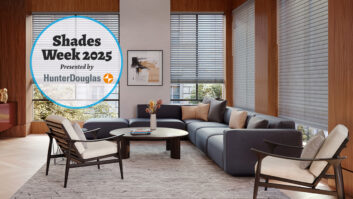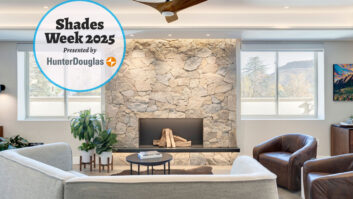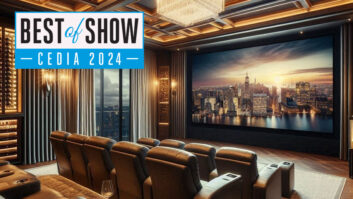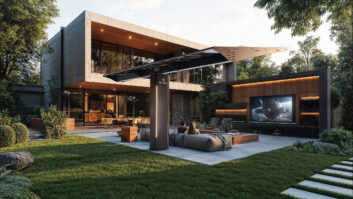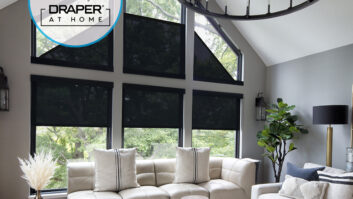They’ve got their ups and downs, but one thing is certain: shades are rightfully claiming the spotlight in any whole-house AV package.
Shades continue to be a profitable category for integrators, says Angie Larson, vice president of sales operations, Savant. “With many other categories becoming commoditized, automated shades represent an opportunity for integrators to add value to each project,” she says. “Plus, with the increasing focus on wellness and energy management in the home, control of natural lighting through automated shades becomes a critical component of healthy living for clients.”
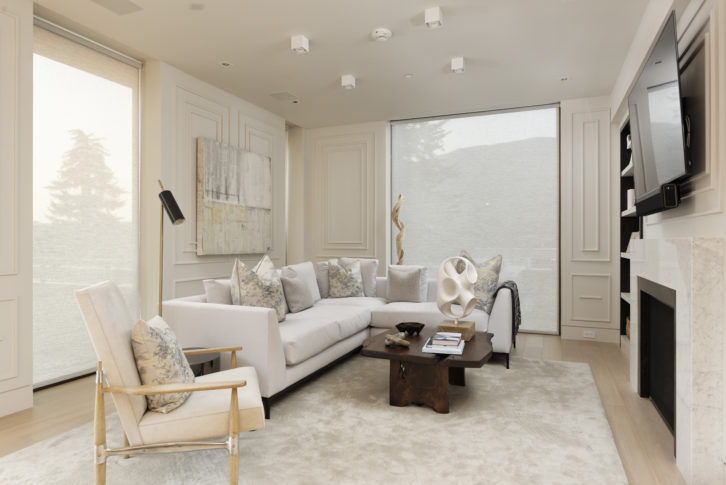
With projects focused on supporting critical smart home principles such as comfort, convenience, wellness, and energy management, shades represent an important component, she adds. “Delivering a complete entertainment experience by automatically lowering shades for watching a movie or sporting event, or offering a wellness experience with shades and artificial lighting acting in harmony, gives clients what only a professional integrator can provide.”
Shades can provide lucrative margins for dealers, explains Cassie Crawford, product marketing manager, QMotion/Legrand AV. “Attracting new clients is challenging; leading installers to have to increase revenue through projects with existing customers. For an integrator already working with the customer on an AV or lighting installation, this is a perfect opportunity for offering automated shades.”
Other Integration Guides: Automation 2019
Customers who are already seeking automated lighting solutions can also benefit from shading solutions, as automated shades can help reduce energy usage, provide glare control in rooms with large screens, such as home theaters, and offer stylish decor on any project, she notes. “Together, lighting control and automated shades provide a full, integrated package that allows end users to control natural and artificial lighting simultaneously.”
And, as smart systems grow in popularity and homeowners engage professionals to handle their AV, lighting, thermostats, and device needs, they expect more design-conscious window treatments over DIY white plastic products, says Scott Stephenson, director of product management, motorization, Hunter Douglas. “These smart home systems are now designed to suit the homeowner’s aesthetic and lifestyle.”
Window treatments, when automated, can enhance the smart home or theater experience, offering comfort, natural light, and privacy management. “As they are a natural extension of the smart home system, shades can be scheduled to rise and lower as the sun moves through the room,” he notes. “They may have been viewed as an add-on in the past, with one-size-fits-all products, but more window treatment options are creating an opportunity for dealers, including for their revenue.”
When automated shades and blinds are customizable, they can create and enhance the ambiance, Stephenson explains. “Top-down/bottom-up shades can lend privacy while still letting in natural light, and the Hunter Douglas LightLock solution can transform a living room from a sunny reading spot into a darkened theater room,” he says. “With colors, fabrics, shapes, and sizes to suit any home, aesthetic, and installation, window treatments are an opportunity for custom integrators to expand their product repertoire and delight their customers.
“With PowerView Motorization, Hunter Douglas shades can easily be added into almost any project, so they can be scheduled, programmed, and controlled via app, remote, or voice command. PowerView works with a long list of top control and smart home platforms from Amazon Alexa and Google Assistant, to Control4, Crestron, Savant, and more.”
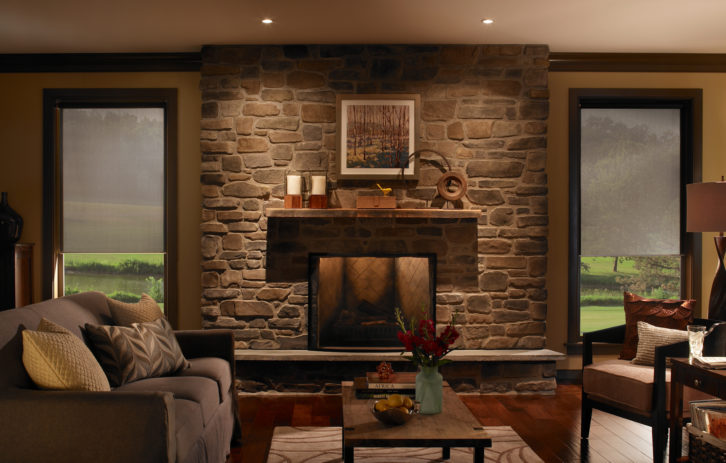
Broaching the Shady Side
One way for integrators to introduce automated window treatments to customers is to add sample books and shades to the demo or showroom experience, Stephenson suggests. “Hunter Douglas takes the custom approach, prioritizing design and style for automated shading; its PowerView operating system can automate over 20 shade and blind styles that are available in hundreds of colors, shapes and sizes, and fabric options. By showing how automated shades can provide privacy, lighting control, and comfort to the user, as well as complement other features in the system such as a projector or screen, multi-room audio, thermostat, lighting, and more, integrators can add shades and blinds to enhance their projects.”
Hunter Douglas just introduced the Custom Integrator Program to make it easier for the CI industry to bring custom automated window treatments to any project, he notes. “Starting with sales and installer training, Hunter Douglas provides tools, presentation books, and samples for integrators to use to demo and showcase the possibilities of PowerView motorization, shade styles, and textiles. With online ordering, access to the entire Hunter Douglas window treatment line, and installation services, integrators can capture the opportunity of automated shades and blinds for small-to-large projects.”
Shades can be introduced in a showroom as part of a scene, Larson suggests: “Showing a good morning scene where shades rise, lights turn on at low levels, and the morning news comes on can be a powerful experience.”
Other Integration Guides: High-End Audio 2019
If a showroom is not available, integrators can discuss the benefits of automated shading based on specific applications such as blocking harsh sunlight on large window walls and creating privacy where needed. “Savant shades, as part of a scene, can be demonstrated in the demo mode of the Savant Pro App, including automatically raising and lowering shades based on time of day or sunrise/sunset,” she says.
The bottom line, Crawford notes, is that shades should be in the budget from the start of the project. “It’s the difference between a car with power windows rather than manual windows” she says. “Window treatments are usually non-negotiable items, making it easier to sell automated shades to a homeowner from the beginning. Ask questions to understand how each space in the home will be used. Is the view more important than privacy? Will a TV or computer be installed, requiring glare control? Is light blockage needed for a better night’s sleep?
“In today’s connected home, customers also want simple one-button total home control. Demonstrate shades as part of a system that automates a scene such as ‘Welcome Home’ that adjusts the lights, starts a music playlist, sets the temperature, and lowers the shades. Window treatments also help reduce energy costs and complement human-centric lighting, both of which are increasingly important issues for customers, translating into a high-growth segment for integrators.”
Other Integration Guides: Getting Smart on Security
What’s the Latest?
“We are continually thinking from the customer’s perspective, focusing on aesthetics and ease of use, and, from the installer’s experience, making our solutions easier and faster to install while seamlessly integrating with many popular home control systems,” Crawford says. “Our new Wider Qadvanced Shades are the industry’s first battery-operated shades available in a variety of fabrics in sizes up to 13-feet wide by 15-feet tall. As many open-concept homes feature larger windows, the Wider Qadvanced Shades allow integrators to install automated, customized shades in less time.”
QMotion also released its QzHub3 for bi-directional ZigBee communication, allowing for standalone app control or integration with leading home control platforms. “Now, customers can control our shades from an app, with a remote, or manually with QMotion’s patented manual override feature,” she says. “In addition, our QIS power and communication panel now features a smaller profile and easier wiring, offering an efficient way to operate QMotion shades. Integrators will also appreciate our affordable Qbasic+ upgradable manual shades. In installs where the budget is limited, homeowners can install our motorized shades in areas where they need them most, while Qbasic+ shades are perfect for low-traffic areas and can be upgraded to motorized shades in minutes, without needing to change the fabric or major bracket reinstallation.”
Savant recently launched battery-powered motors for exposed shades with J Geiger’s sleek, minimalist brackets. “The battery is inside the shade, so there’s no need for an outdated looking cassette or fascia because there are no batteries to hide,” says Larson. “In a Savant solution, these batteries are rechargeable, eliminating the need for large quantity battery replacement and the environmental implications associated with battery disposal.
“These shades are an ideal solution for retrofit projects when getting wires to the windows is challenging or impossible. Voice control has also simplified the user operation thanks to Savant’s amazing hand-held Pro Remote. The latest application features the addition of Apple Home Kit, Amazon Alexa, and Google Home integration, expanding voice scene control capability to areas of the home where a remote is not present.”
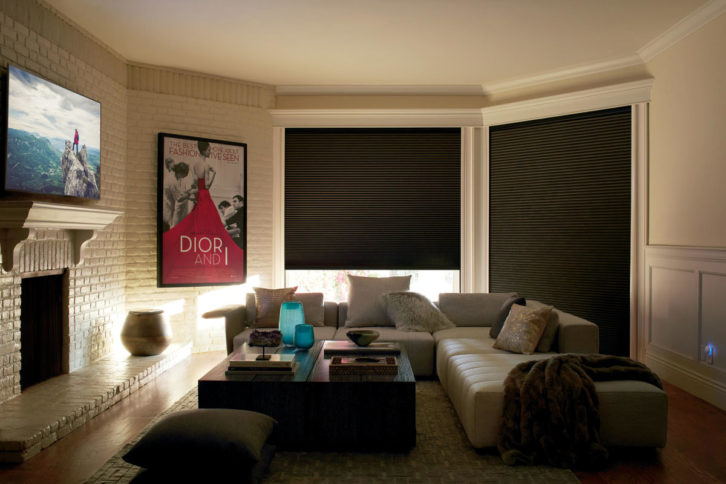
Keep in mind that automated window treatments don’t have to be one-size-fits-all, Stephenson advises. “Roller screen shades may be great in the expansive living room, and a top-down, bottom-up or sheer vane product is better suited to a bedroom or bathroom where privacy is a concern,” he says. “Hunter Douglas takes a design-first approach to ensure that integrators can specify the right shape, size, color, and fabric for any project, plus compatibility with almost any smart system. PowerView Motorization is the operating system that makes over 20 Hunter Douglas shade and blind styles smart; they can be scheduled, programmed in scenes, or controlled via voice command, app, or remote control independently or as part of a system.”
Hunter Douglas shades are custom ordered for each home in the colors and textiles to suit the aesthetic, and integrators can get help measuring for tricky window shapes and sizes. “The variety of styles can suit different rooms; top-down/bottom-up Duette Honeycomb shades allow natural light and privacy control, while helping to manage the temperature in the room for energy efficiency,” Stephenson says. “On the other hand, the unique Pirouette Window Shadings combine horizontal vanes and sheer backing to diffuse sunlight while providing an outside view.”
With PowerView, shade operation for homeowners is simple and intuitive, Stephenson says. “A variety of control methods and scheduling options allow homeowners to adjust, raise, darken, or close their window treatments to suit their lifestyle, whether getting ready for bed, watching a movie, waking up in the morning, or letting in more light to work from home,” he says. “End users can create their own schedules and scenes for their shades independently of the control or voice systems, so integrators only have to do the initial programming to get their customers started.”
